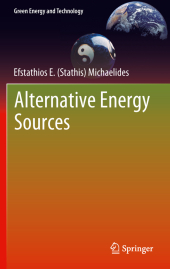 Neuerscheinungen 2014Stand: 2020-02-01 |
Schnellsuche
ISBN/Stichwort/Autor
|
Herderstraße 10
10625 Berlin
Tel.: 030 315 714 16
Fax 030 315 714 14
info@buchspektrum.de |

Efstathios E. (St Michaelides
Alternative Energy Sources
2012. 2014. xviii, 462 S. 138 SW-Abb.,. 235 mm
Verlag/Jahr: SPRINGER, BERLIN 2014
ISBN: 3-642-43907-1 (3642439071)
Neue ISBN: 978-3-642-43907-0 (9783642439070)
Preis und Lieferzeit: Bitte klicken
This book offers a clear view of the role each form of alternative energy may play in supplying energy needs in the near future. It details the most common renewable energy sources as well as examines nuclear energy by fission and fusion energy.
Alternative Energy Sources is designed to give the reader, a clear view of the role each form of alternative energy may play in supplying the energy needs of the human society in the near future (20-50 years).
The two first chapters on "energy demand and supply" and "environmental effects," set the tone as to why alternative energy is essential for the future. The third chapter gives the laws of energy conversion processes, as well as the limitations of converting one energy form to another. The section on exergy gives a quantitative background on the capability/potential of each energy source to produce power. The fourth, fifth and sixth chapters are expositions of fission and fusion nuclear energy, the power plants that may produce power from these sources and the issues that will frame the public debate on nuclear energy. The following five chapters include descriptions of the most common renewable energy sources (wind, solar, geothermal, biomass, hydroelectric) some of the less common sources (e.g. tidal and wave energy). The emphasis of these chapters will be on the global potential of each source, the engineering/technical systems that are used in harnessing the potential of each source, the technological developments that will contribute to wider utilization of the sources and environmental effects associated with their wider use. The last three chapters are: "energy storage," which will become an important issue if renewable energy sources are used widely.
The fourteen chapters in the book have been chosen so that one may fit a semester University course around this book. At the end of every chapter, there are 10-20 problems and 1-3 suggestions of semester projects that may be assigned to students for further research.
Energy Demand and Supply.- Environmental effects of energy use - The laws of thermodynamics.- Nuclear energy.- Nuclear Power Plants.- Fusion energy.- Wind Power.- Geothermal Energy.- Solar Energy.- Biomass/biofuels.- Other renewable sources of energy.- Energy storage.- Energy Conservation.- Economics of Energy Projects.
Efstathios E. (Stathis) Michaelides, Ph.D., P.E. is Professor and Chair of the Department of Mechanical Engineering. His Educational Background is B.A. Oxford University M.S., Ph.D. Brown University. His Areas of Teaching Interest are Energy Conversion, Thermodynamics and Fluid Dynamics. His Areas of Research Interest are Thermodynamics of Advanced Energy Conversion Devices, Energy Systems, Energy Conservation, HVAC, Multiphase Flow and Heat Transfer, Particulate Flow and Environmental Fluid Dynamics, Sediment Flow, Separation Processes, Materials Handling.


